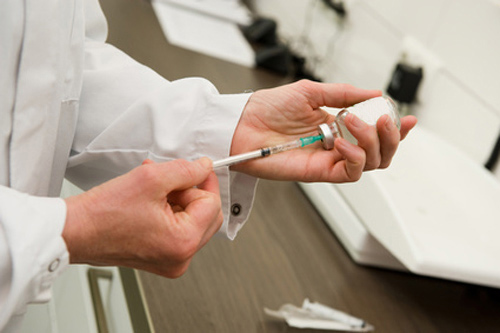Scientists in Australia have developed a method for the rapid synthesis of safe vaccines, and say their approach can be used to create and test potential vaccine strategies against respiratory pathogens, including SARS-CoV-2. Headed by Richard Payne, PhD, at the University of Sydney, and Warwick Britton, PhD, at the Centenary Institute, the research team demonstrated application of their method with the development of a synthetic, self-adjuvanted protein vaccine against tuberculosis (TB), which generated a powerful protective immune response in mice.
“Tuberculosis infects 10 million and kills more than 1.4 million people every year,” said Anneliese Ashhurst, PhD, from the University of Sydney, who is joint first author of the team’s published paper in Proceedings of the National Academy of Sciences (PNAS). “Historically, it is the leading cause of death worldwide from a single infectious agent. So far, a TB vaccine that is highly effective and safe to use in all populations has eluded medical science.”

While vaccination is the most effective strategy for preventing many infectious diseases, so far, vaccines against Mycobacterium tuberculosis, the bacterium that causes TB, have shown “limited efficacy,” the authors wrote. The only current vaccine for tuberculosis, the Bacille Calmette-Guerin vaccine, uses an injected live bacterium. It is effective in infants but has reduced effectiveness in adolescents and adults, and poses significant health risks for immunocompromised patients, and particularly for people living with HIV/AIDS. “There is therefore an urgent need to develop new types of vaccines that provide safe and more effective protection against TB,” the team stated.
Protein-based vaccines have been shown to be very safe, but they must be mixed with enhancers, or adjuvants, to make them effective, which is not straightforward. In the case of tuberculosis, the immune system needs to respond quickly to the causative M. tuberculosis bacterium, to reduce infection in lungs. If a vaccine is to be effective, it needs to stimulate behavior in protective T-cells that allows them to recognize the pathogen as an antigen.
The new method developed by the Sydney scientists generates an inhaled vaccine that delivers a low-dose immune-stimulating molecule – containing a synthesized bacterial protein attached directly to an adjuvant – to the immune cells in the lungs. “The challenge is to ensure that our immune cells see both the protein and adjuvant simultaneously,” Ashhurst explained. “To overcome this difficulty, for the first time we have developed a method that synthesizes the protein with an attached adjuvant as a single molecule.”
To generate their vaccine, the scientists had to negotiate the major hurdle of how to fuse hydrophobic (water-repellent) adjuvants with a water-soluble protein antigen. “The majority of adjuvants are hydrophobic lipopeptide or glycolipid molecules,” the researchers explained. “A major difficulty in generating self-adjuvanting vaccines is the fusion of an aqueous soluble protein with the hydrophobic adjuvant molecule.”

The vaccine constructs generated by the researchers comprised a low-dose immune-stimulating adjuvant, covalently fused to the ESAT6 protein from M. tuberculosis. When administered to mice by inhalation, the vaccines generated powerful immune responses and significant protection from M. tuberculosis in the lungs.
The team says that synthesizing an entire bacterial protein with attached adjuvant has not been achieved before. “As well as providing a rapid method to develop a range of vaccines for pre-clinical testing, we expect that this pulmonary vaccination approach will be particularly beneficial for protecting against respiratory diseases,” added Britton, from the Tuberculosis Research Program at the Centenary Institute. “We hope that an inhaled vaccine for tuberculosis using a protein-based immunization will allow us to develop a universal and safe approach to combatting this deadly disease.”
The researchers say the other major advantage of their method is that it allows vaccines for a range of diseases to be developed rapidly and safely in the laboratory. “We don’t need to grow the actual pathogen in the lab to make the vaccine,” said Ashhurst, who holds a joint position in the School of Chemistry and the School of Medical Sciences. “Using this new method, we can rapidly and safely synthesize highly pure vaccines in the lab and take them straight into animal models for preclinical testing.”

The vaccine strategy and synthetic technology could be deployed to rapidly generate new vaccines for preclinical testing for a range of diseases, the team suggested. The synthetic strategy we describe represents a method that could be used to rapidly generate vaccines for preclinical testing against many diseases, including novel pathogens such as SARS-CoV-2.”


